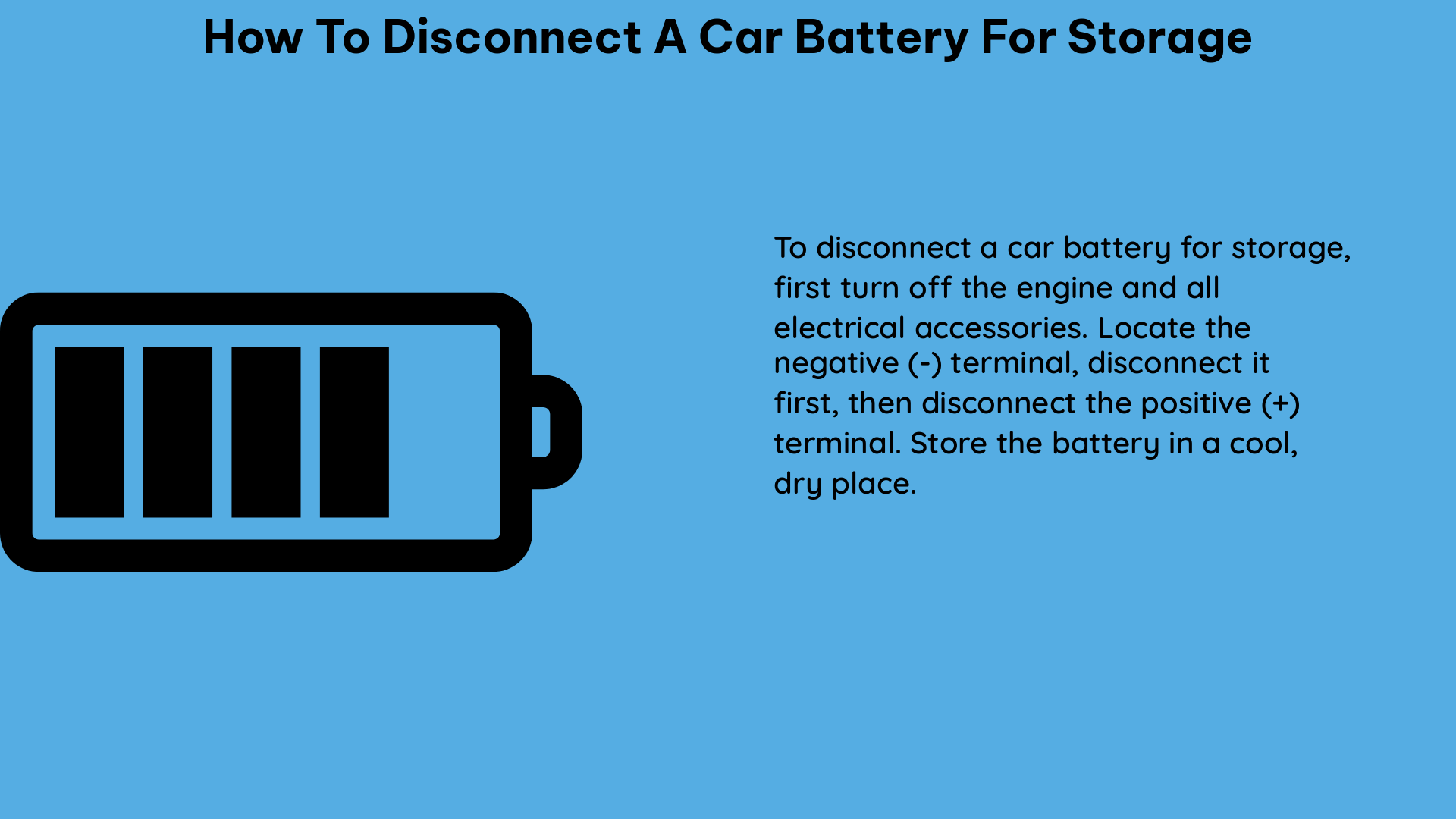When storing a car for an extended period, properly disconnecting the battery is crucial to prevent damage to the vehicle’s electrical system and ensure a smooth restart when the car is brought back into use. This comprehensive guide will walk you through the step-by-step process of disconnecting a car battery for storage, covering essential safety precautions, technical specifications, and expert-recommended best practices.
Understanding Car Battery Basics
Before delving into the disconnection process, it’s essential to understand the fundamental characteristics of car batteries. Most modern vehicles use lead-acid batteries, which are susceptible to self-discharge and can be damaged by extreme temperatures. Knowing the technical specifications of your car’s battery will help you navigate the disconnection process with confidence.
Battery Type and Voltage
- Battery Type: The majority of car batteries are lead-acid batteries, which are rechargeable and store energy through a chemical reaction.
- Voltage: A typical car battery has a voltage of 12 volts, with a fully charged battery measuring at least 12.6 volts.
Terminal Types and Corrosion Prevention
- Terminal Types: Car batteries have two terminals, positive (marked with a “+” symbol) and negative (marked with a “-” symbol).
- Corrosion Prevention: Regular inspection and cleaning of the battery terminals can help prevent corrosion, which can lead to poor electrical connections and reduced battery performance.
Preparing for Battery Disconnection

Before you begin the disconnection process, it’s crucial to ensure the proper safety precautions are in place. This includes turning off the car, wearing eye protection, and gathering the necessary tools.
Safety Precautions
- Turn Off the Car: Ensure the car is turned off and the ignition is in the “off” position to prevent any electrical shorts or sparks during the disconnection process.
- Wear Eye Protection: Always wear safety glasses or goggles to protect your eyes from potential battery acid or debris.
- Use Appropriate Tools: Gather a 10-millimeter wrench or socket, as well as any other tools required for your specific vehicle model.
Gathering Necessary Tools
- 10-millimeter Wrench or Socket: This is the most common tool used to loosen the battery terminal bolts.
- Rag or Plastic Cup: To cover the positive terminal and prevent it from touching the battery or any metal surfaces.
- Battery Tie-Down Removal Tool: If your vehicle has a battery tie-down, you’ll need a tool to remove it.
Step-by-Step Guide to Disconnecting the Battery
Now that you’ve prepared the necessary safety precautions and gathered the required tools, let’s dive into the step-by-step process of disconnecting the car battery for storage.
-
Locate the Battery: Identify the battery’s location in the engine compartment. It is typically situated near the front of the vehicle, either on the left or right side.
-
Identify the Terminals: Locate the positive (red) and negative (black) battery terminals. These are the two metal posts that the battery cables connect to.
-
Disconnect the Negative Terminal: Using the 10-millimeter wrench or socket, loosen the bolt on the negative (black) terminal first. Gently lift the negative cable away from the battery.
-
Disconnect the Positive Terminal: Next, loosen the bolt on the positive (red) terminal. Carefully lift the positive cable away from the battery, ensuring it does not touch any metal surfaces.
-
Cover the Positive Terminal: To prevent the positive terminal from accidentally touching the battery or any metal surfaces, wrap the positive cable in a rag or cover it with a plastic cup.
-
Remove the Battery Tie-Down: If your vehicle has a battery tie-down, use the appropriate tool to remove it, allowing the battery to be lifted out of the engine compartment.
-
Lift the Battery: Carefully lift the battery out of the engine compartment, being cautious not to tip it if it’s a flooded battery.
-
Clean the Battery Tray: Use a wire brush or sandpaper to remove any corrosion from the battery tray, clamps, and the battery itself.
-
Store the Battery: Place the battery in a cool, dry place, away from direct sunlight and extreme temperatures. If storing the battery for an extended period, consider using a battery maintainer or charger to keep it in optimal condition.
Maintaining Subsystem Settings
For those concerned about preserving the settings of various subsystems in the vehicle, such as radio presets, computer parameters, and other vital data, using a memory saver or backup battery is recommended.
Memory Saver or Backup Battery
- Memory Saver: A memory saver is a device that connects to the vehicle’s OBD II diagnostic port and maintains power to the vehicle’s computer system, ensuring that important settings are not lost during the battery disconnection process.
- Backup Battery: Alternatively, you can use a backup battery connected to the OBD II port to achieve the same result, preserving the vehicle’s subsystem settings while the main battery is disconnected.
By following these comprehensive steps and understanding the technical specifications of your car’s battery, you can safely and effectively disconnect the battery for storage, ensuring your vehicle is ready for a smooth restart when you’re ready to use it again.
References:
- Battery Removal or Just Disconnect Neg Terminal
- How to Disconnect a Car Battery for Storage
- How to Disconnect Car Battery Terminals Safely
- Which Battery Cable Do You Disconnect for Storage?
- How to Disconnect a Car Battery

The lambdageeks.com Core SME Team is a group of experienced subject matter experts from diverse scientific and technical fields including Physics, Chemistry, Technology,Electronics & Electrical Engineering, Automotive, Mechanical Engineering. Our team collaborates to create high-quality, well-researched articles on a wide range of science and technology topics for the lambdageeks.com website.
All Our Senior SME are having more than 7 Years of experience in the respective fields . They are either Working Industry Professionals or assocaited With different Universities. Refer Our Authors Page to get to know About our Core SMEs.